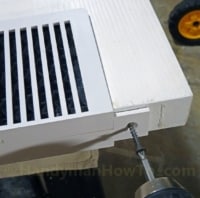This project shows how to Install a Tamarack Perfect Balance In-Door Return Air Pathway in a hollow core interior door to pressure balance the room. Also see the Tamarack Perfect Balance In-Door Return Air Pathway Review for the project introduction.
How to Install a Tamarack Perfect Balance In-Door Return Air Pathway
Remove the door from it’s hinges by driving out the hinge pins and lay the door on a pair of saw horses. I put a painters drop cloth over the saw horses to avoid marring the door finish but bath towels will do.
Door Template
The Tamarack vent installation instructions are printed on back of the box with a full size template. Cut out the template, mark and saw:
Measure Cutout by Hand
I found the cardboard template to be oversized which benefits the novice installer. Instead of using the template I preferred measuring the actual width (24-1/4 inches) and height (4 inches) of the inner frame, then added 3/16 inches to each measurement for clearance, or 24-7/8 inches by 4-3/16 inches respectively. Next I:
- Measure and make a tick mark at the center of the door bottom (15-7/8 inches) on this nominal 32 inch wide hollow-core interior door using a pencil. Note the actual door width is 31-3/4 inches, therefore the center mark is made at 15-7/8 inches.
- Measure and mark the left and right sides at 12-7/32 inches from the door center tick mark;
12-7/8 in = 24-7/8 in vent length divided by 2. - Verify the total length between the left and right marks is 24-7/8 inches.
- Used the square to measure and mark the left and right sides 4-3/16 inches high at a right angle to the door bottom.
- Mark the top horizontal line between the left and right sides using an aluminum yard stick.
- Trace over the pencil marks with a felt tip pen for better visibility in the photo:
Saw the Door Bottom
A jig saw is needed make the vent cutout in the door. I used a down-cut fine toothed laminate blade in my DEWALT DW331K jig saw which has a plastic non-marring plastic shoe cover. I sawed the left side first, moved over to the right side making an interior radius at the right corner to cut across the middle, then trimmed the corner radius to square it:
Remember to remove any burrs from the sawn edges (I just run my fingers along the edge) and vacuum the sawdust inside and out:
These interior hollow-core doors cost less than $40 pre-bored for the door knob so it’s not a disaster in the unlikely event you make a blunder and have to replace the door.
Install the Door Return Vent
The Tamarack in-door vent is tapped into the door cutout. Mine fit great with no binding:
The Tamarack vent is secured to the bottom door frame with two bugle head screws (screws are not included). Rummaging through my workshop I found that 1-5/8 inch long by 8 gauge coarse thread drywall screws had the right head size and fit perfectly:
Drive a screw in the vent mounting flange on both sides to fasten it to the door. Don’t overtighten the screws to avoid tearing out the wood:

The in-door return vent installation is complete:
Hanging the lightweight interior door back on the hinges was quick and easy. Set the door on the hinges, close the door and insert the hinge pins:
Tamarack Perfect Balance In-Door Return Air Pathway Performance
The Tamarack door return vent made a big difference in air circulation when the door is closed! The room is now comfortable without the stuffy feeling. Standing outside the bedroom with the door closed and the AC running, I feel a steady breeze through the door vent against my hand.
The honeycomb baffle does an excellent job limiting light transmission. The only light I saw in the darkened hallway was reflected around the door jambs and beneath door from the polished Skimstone concrete floor. No light was seen when standing. I had to lay down and look directly through the baffles to see light inside the room.
Noise transmission was more difficult to assess with a radio playing in the bedroom. It sounded like most of the music was transmitted through the hollow-core door itself. I blocked the vent with a chair cushion and it sounded about the same with the music coming through the gap between door bottom and floor.
Enjoy,
Bob Jackson